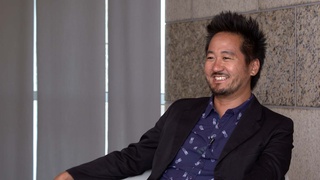Interviews
Meeting Kinnara Taiko
Every time we play drum, I think I attract people because that’s very quite unusual at that time. So people start to want to join. That’s also another reason I have to learn more music, more taiko. So every time I go to Japan. Part time job, and I gain money and go to Japan. Study. More study. And every time, bring the drum.
So until ’69, Koyasan-ho(?)—do you remember? Koyasan-ho in Little Tokyo. Nagano kenjinkai—like a Nagano prefecture people’s crowd—invite us to play taiko. So then I met the Kinnara Taiko group. Those people had a bookstore, Amerasia, American Asian, bookstore. This is the first time I ever met those people.
They are making their own drum. That was a big culture shock. I never thought to make the drum. My knowledge of taiko is always carpenter, special taiko carpenter, make the drum. But this is a revolution. Revolution. Those guys make the taiko revolution. Without their idea of using barrel, wine barrel—cut, (?) the skin. Some not as good as original Japanese taiko. But they can make it in an inexpensive way. I think that made taiko history in the United States. That’s very, very important [that] JA’s start to make—everybody—start to make own taiko.
Date: January 27, 2005
Location: California, US
Interviewer: Art Hansen, Sojin Kim
Contributed by: Watase Media Arts Center, Japanese American National Museum.





